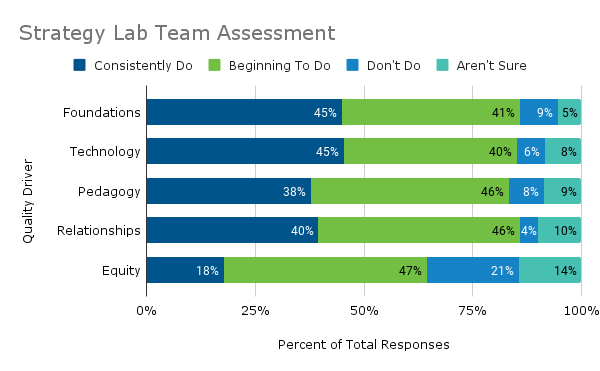
In working to prove their worth in an ever-changing education landscape, virtual and hybrid schools across the country are looking to hone their craft and make improvements. Over the past year at The Learning Accelerator (TLA), we have supported 20 district-based virtual and hybrid programs to do just that, guiding them to identify actionable ways to make their schools work better for more kids. We know what works in virtual and hybrid learning, but our teams needed help uncovering what was not working with their model. Like many virtual schools, they did not know where to start or what was most important to prioritize. To help them solve this, TLA built a needs assessment tool for virtual and hybrid learning. The tool provided a starting point for each district team, helping them identify a high-priority problem of practice to address in their virtual program. While these insights helped each district focus on a particular area for improvement, when taken collectively, these needs assessment also revealed themes about the state of virtual and hybrid learning for district and school leaders to consider when evaluating their own virtual or hybrid programs.
The Process: How The Assessment Uncovers Opportunities
The research-based framework that undergirds the needs assessment tool includes five broad drivers essential to successful virtual learning: Foundations, Technology, Pedagogy, Relationships, and Equity. Teams use a modified version of the Stoplight Protocol from DataWise to indicate the degree to which each driver exists in context — consistently, in pockets, or not at all — with evidence. Strategy Lab participants completed the self-assessment individually, then worked collaboratively on the team assessment, comparing their responses in the self-assessment. After using a modified Praise-Question-Polish Protocol, teams honed in on a single area of concern to dig deeper into. Teams investigated their focus area through empathy interviews, surveys, and data analyses that helped participants paint a better picture of their problem of practice. By starting with the team assessment and taking a methodical approach, teams were confident that the area for improvement they were focused on was the right one.
Needs Assessments Reveal Broad Trends in Virtual & Hybrid
Our synthesis of needs assessment data, team workbooks, meeting notes, empathy interviews, and artifacts across Strategy Lab teams exposed trends across virtual and hybrid programs. The strengths and gaps identified shed light on the opportunities for growth in virtual and hybrid learning environments.

Theme 1: Virtual learning programs are built on a bedrock of technology access
Unlike in-person learning, virtual learning relies almost entirely on access to a device and the internet. Therefore, it’s not surprising that Strategy Lab teams expressed the most confidence in their use of technology, with universally high marks for high-speed internet and device access. Additionally, virtual programs rated tools they use as consistently offering the functions required to meet learning objectives and offer content through a variety of modalities.
However, there were also areas for improvement with technology. Student ownership of devices and their ability to configure them to meet their learning needs scored much lower, indicating an opportunity to increase equity, especially for students with varied learning needs.
Theme 2: The needs assessment helped districts uncover less obvious, but equally important aspects of virtual learning design
Shoring up foundational elements of virtual learning
While technology makes virtual learning possible, research demonstrates that there are additional foundational elements essential for virtual learning to thrive. These components include setting and communicating clear expectations to stakeholders, building relationships with students, supporting students in becoming self-directed learners, and supporting students’ non-academic and social-emotional needs. Our synthesis of needs assessments revealed gaps across virtual programs in establishing these foundational elements. For example, most teams assessed that they were beginning to “articulate clear expectations for virtual/hybrid learning to students and their families.” Only four teams felt they consistently “provide specific instruction to help students become independent, self-directed learners.” Of concern, only half of the Strategy Lab teams reported consistently supporting their students’ social-emotional needs. These data point to foundational gaps in virtual learning programs.
Given the relative importance of these elements for virtual learning programs, many Strategy Lab teams focused their efforts on these foundational elements. Initial data from revised team assessments, which Strategy Lab teams repeated a year after their first team assessment, show significant growth in setting and communicating expectations. Nine teams used the Strategy Lab process to focus on improving how their program attends to students’ social-emotional needs — more than any other category. Another area of piloting focus was on student belonging and building community. For example, Cajon Valley Union School District in California piloted in-person learning opportunities for students and families to build community and social networks. The Cooperative Virtual Learning Academy, a regional virtual program in New York, tested an intake process for newly enrolled students to facilitate a smooth transition into their virtual classroom communities. Four teams piloted instructional strategies for increasing one-on-one teacher-student time, both to build deeper relationships and improve academic outcomes. By starting with the needs assessment, each team was able to identify and prioritize key foundational elements of their program for improvement.
Increasing equity in virtual learning
Equity stood out as another area for attention: no teams in our Strategy Lab cohort agreed in their team assessment that they consistently currently achieve their goals or benchmarks for success in their current equity plan for online/hybrid learning, pointing to the need for virtual programs to focus on designing for equity. In that same assessment, most teams indicated they were beginning to create a concrete vision for virtual learning that “describes how students will experience an engaging, effective, and equitable learning environment,” leading many to consider how explicit their equity plans were. Additionally, some districts rated they don’t actively seek out and prioritize “the voices and perspectives of traditionally-excluded families and students” to “improve our virtual/hybrid learning environment.”
Many teams’ problems of practice and subsequent pilots focused on increasing equity. For example, Matrix Academy for Success in California created a support group for students who are parenting or expecting, an equitable solution for improving outcomes for their kids. Across the country in Washington, D.C., Friendship Public Charter School targeted outreach and enrollment processes to create more equitable access to their virtual program. Novi Public Schools in Michigan similarly sought to increase equitable access, specifically targeting multinational families who travel internationally for extended periods. Novi piloted a more flexible instructional model that includes asynchronous assignments that can be completed anytime, anywhere. In another approach to increasing equity, multiple teams piloted targeted advising programs to support students with the greatest opportunity for growth. Each of these pilots was hyper-specific to the unique needs and context of each district’s program, but all prioritized opportunities to increase equity.
By starting with a research-based, holistic assessment of the state of their virtual program, Strategy Lab teams were able to uncover high-priority areas for improvement to tackle. Rather than chasing shiny technology or targeting minimally impactful problems, the needs assessment process sheds light on the highest-priority challenges and opportunities for improvement — especially around issues of equity and foundational aspects of virtual learning design.
Virtual and hybrid programs can benefit from this same process to uncover opportunities for improvement in their context. By starting with TLA’s individual and team assessment tools and following the Real-Time Redesign process, virtual and hybrid programs can lead their internal improvement process confident that they’re focused on improvement where it’s needed most.

